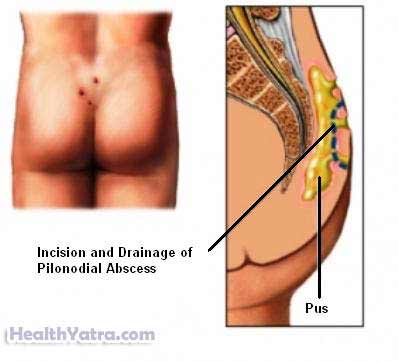Definition
An abscess is an inflamed and infected pocket of pus in the skin. It is often called aboil. Incision (cut) and drainage is a procedure to drain pus from an abscess.

Reasons for Procedure
Drainage of an abscess is the preferred treatment to clear an abscess. It is often used if the abscess is large, growing, painful, or not improving on its own.
Do not pop or cut an abscess yourself. This can spread infection and make it worse.
Possible Complications
Possible complications may include:
- Pain
- Bleeding
- Scarring
Factors that may increase the risk of complications include:
- Smoking
- Diabetes or other conditions that weaken the immune system
What to Expect
Prior to Procedure
- Your doctor will examine the abscess.
- An ultrasound or other imaging method may be used if the abscess is large or deep. Blood tests may also be used to find out how severe the infection is.
- Your doctor may make sure your tetanus immunizations are current.
Anesthesia
A local anesthesia will be applied to your skin. This will make the area numb.
Description of Procedure
Most of the time, this procedure can be done in your doctor’s office. Large, deep abscesses, or abscesses in sensitive areas (eg, near the anus), may require treatment in the hospital.
The area will be wiped with a special cleansing fluid. Anesthesia will be applied. A small incision will be made. A syringe or catheter may be used to drain the pus from the abscess or the pus may be squeezed out. Gauze may be used to soak up the fluid. A clean water mixture will be used to flush the area.
A tool may be used to explore inside the cut. It can also help break down the abscess. A sample of the bacteria may be taken with a cotton swab for testing. Sometimes, the doctor will decide to pack the wound with clean gauze. This will help make sure the abscess does not form again. If this happens, you will come back in a day or two to remove or replace the packing. Gauze and dressing tape will be used to cover the wound.
How Long Will It Take?
30-45 minutes
Will It Hurt?
No, the procedure should not hurt. You may feel a slight pinch and burning when the local anesthetic is injected.
Post-procedure Care
At Home
Take the following steps to help ensure a smooth recovery when you return home after the procedure:
- Take all medicine as directed. If you are taking an antibiotic, take it at the same time(s) each day. Finish the entire course.
- Change your bandages as directed. Wash the wound as directed by your doctor. Replace bandages with sterile bandages that your doctor gives you.
- Ask your doctor about when it is safe to shower, bathe, or soak in water.
- You may need to limit movement of the affected area to give it time to heal.
- Follow up with your doctor as directed.
The skin should heal completely in about 14 days.
Call Your Doctor
After arriving home, contact your doctor if any of the following occurs:
- Worsening pain
- Redness
- Swelling
- Bleeding
- Fever and chills
- Rash or hives
In case of an emergency, call for medical help right away.
